Contents
Authors of the holy texts
1. The unparalleled Maharshi Vyas
1A. Various names
‘Sage Vyas is known by various names. He was called Krushna because of His dark complexion and Dvaipayan because He was born on an island (dvip). It also became customary to call him Krushna Dvaipayan as a combination of the above two names. He is called Vyas (व्यास) since He brought about the division of the Vedas ‘वेदान् विव्यास’. As the son of Sage Parashar He is known by the name of Parasharya. Amongst scholars He is called Bhagvan Vyas the title bestowed upon Him by Shri Shankaracharya. At times He is also called Maharshi.
1B. A remarkable writer
‘व्यासोच्छिष्टं जगत्सर्वम् meaning Vyas has not left any knowledge in the world untouched’, has become a common statement. In geometry vyas is the longest line (diameter) within a circle. Similarly Vyas’ literature is also the greatest. Very rarely does such a personage take birth over the yugs (eras). It is indeed a great, eternal pride for Indians in the times to come that Vyas was born in India. It would not be an exaggeration to consider that till today the world has not produced nor will produce such a noble and literary writer with an all pervading divine intellect, in the future. From the post-Vedic period till today Vyas has been considered as the very soul of Indian tradition (sanskruti). Our culture is based on the Mahabharat written by Vyas and the Purans. If one wishes to understand Indian culture in all aspects then one compulsorily has to study the holy texts written by Vyas. Vyas’ literature is the very backbone of Indian culture.
1C. Vyascharya
The following holy texts written and compiled by Sage Vyas are together known as the Vyascharya.
-
The Vedic divisions: Sage Vyas has divided the Vedas based on the topics. For details on this refer ‘Creation of the four Vedas’.
-
The Brahmasutras : Refer point ‘The Prasthanatrayi’.
-
The Purans: Sage Vyas is the foremost author of the Purans. The Bhagvatpuran is the most important among these.
-
The Mahabharat: Refer point ‘The Mahabharat’.
1D. Vyas and national upliftment
Vyas saw a vast vision of time and space beginning from the unknown past to the present and from the Himalays in North India to Kanyakumari in South India. He was committed to the cause of prosperity of this state. If a country has to be happy, prosperous and developed in all spheres, then it has to have political stability. The ruler has to be moralistic, chaste, powerful and cautious on all fronts. If he is not powerful then evildoers will exploit the righteous and Righteousness (Dharma) will plunge to its depths. A country has a common code of Righteousness based on the vigilance and propriety of the administration. That is why Vyas has given detailed and appropriate guidance to the administration.
1E. Vyas and Righteousness (Dharma)
His concept of Righteousness is that, that which nurtures and safeguards the state, the entire creation, the earth and the other regions, in all circumstances and at all times is Righteousness. The core of the stability of the populace is Righteousness. Righteousness is not merely the search for heaven or the Final Liberation (Moksha) rather it is that which sustains people in the material world making them happy, prosperous, mutually amicable, moralistic and in search of the four pursuits of life (purusharthas). If Righteousness (Dharma) is an excellent means of making life meaningful then it too must be equally precious. According to Him life is Blissful and is not meant for weeping or sulking. One cannot forsake it thinking that it is the Great Illusion (Maya). Vyas believes in the Law of Karma on the earth, so also the philosophy of destiny. He also has faith in Spirituality or the soul principle. Human life is supported by two pillars i.e. worldly transactions or economics and the administrative system or the code of punishment. In the world nothing is possible without money, and human finance in turn is dependent on the code of Righteousness of rulers (rajadharma); hence the king should rule moralistically and the subjects should remain righteous. One should earn wealth maintaining one’s self-respect and should not aspire to acquire anything by undignified means. The path followed by beggars or dacoits is not at all proper no matter how much wealth is acquired through it. Man should always place the ideal of earning wealth through hard work, before him.
1F. Integration of sects
Krushnadvaipayan Vyas is very renowned not only in Indian but also in world literature. It is impossible to find another as great as Him. Though Homar and Valmiki may be compared with Him to some extent yet there is a vast difference between Vyas and Them. Valmiki wrote a beautiful poetry bestowing divinity upon a member of the royal family. This is certainly not a simple task to perform. Nevertheless it cannot match that of Krushnadvaipayan. None in this world other than Vyas thought of the concept of bringing about universal integration through literature and put it into practice.
The Rugveda was a sect of the Somyajis [those who performed the Somyag (sacrifice)] from Panjab in India. The Yajurveda was a sect from South India which undertook animal sacrifices. The Samaveda is a very old sect of those undertaking satras (institutions in which sacrificial fires are held from 13 to 100 days) while research shows that the Atharvaveda is the evolution of the lineage of the ancient Mags, the residents of Magadh. Sage Vedavyas performed the task of creating a general code of Righteousness by uniting the sects performing sacrificial fires (yadnya) as spiritual practice of these varied people, the end result of which is today’s composition of the four Vedas. Because of this composition every Veda instead of remaining in a different code of Righteousness (Dharma) became a part of one broad code of Righteousness. The large organisation which Vyas established to perform this gigantic task led to the bestowal of the title of ‘Kulapati’, meaning head of the family. The sociological principle that union of people of all lands occurs by integrating their knowledge and one can overcome the opposition due to the various sects by this integrating attitude, was realised by Vyas and that is how He composed His great works. Vedavyas began preaching the integrated knowledge in a different manner all over again. He also realised that the practice of performing sacrificial fires was not preached to the common man; in fact the righteous code of the commoner was extremely different. There are different local deities, places of pilgrimage, sacred places, legends of the brave and slayers of demons, spiritual practice of the trinity of the deities Shiva, Vishnu and the female deity (devi) at all places. A caste originating from interclass marriage (sut varga) has preserved this ancient literature safely so as to facilitate all these deeds. In such circumstances mere integration of practices of those offering oblations (havi) in the sacrificial fire will not help in unifying the society. Rather, the sects of worship of the commoners too have to be unified along with blending of their literature. It was with this perspective in mind that Vedavyas began the task of making all literature comprehensive. The mission that He took up later expanded because of His followers and consequently He came to be known as the pioneer of all the Purans.’(1)
1G. Ritualistic worship (puja) of Shri Vyas
Vyas is known as the foremost Guru (Adiguru) because of His great composition of holy texts. (Followers of the Shaiva sect refer to Shiva and those of the Datta sect refer to Datta as the foremost Guru). On the full moon day (paurnima) of the month of Ashadh, to express gratitude to the Guru, disciples celebrate Shri Gurupaurnima. On that occasion before worshipping one’s Guru, Sage Vyas is worshipped to commemorate His death anniversary.
1H. Vyas’ seat (Vyaspith)
The dais used by a speaker addressing a gathering is known as Vyas’ seat (Vyaspith). ‘One who ascends such a seat has to observe certain norms. First and foremost he should not speak anything which would be unacceptable to Vyas and that is precisely why he should be well read in literature. He should not criticise or praise anyone needlessly. He should be a true devotee of deity Sarasvati (the deity of learning), that is in other words he should be a learned man. His speech should depict devotion unto God rather than literary expertise. Lastly, like Sage Vyas such a person’s speech should be righteous, straightforward, depicting knowledge and should make an attempt to bring about the welfare of society.’(2)
2. Vaishampayan and Yadnyavalkya
‘Vaishampayan’s mission is not merely the preaching of the Krushna Yajurveda but also that of transforming Vyas’ holy text ‘Jay’ to ‘Bharat’ which is of the same calibre. Vaishampayan was the first one to whom Vyas recited His holy text named Jay. It was confined only to the conflict between the Kauravs and Pandavs and had only 8,800 verses (shlokas). Vaishampayan expanded this text to one with 24,000 verses and named it Bharat. Vaishampayan was the royal priest of Arjun’s grandson, King Janmejay who was keen on hearing the story of his ancestors and requested Vaishampayan to narrate it. The latter narrated it to the former but elaborated it and called it the Bharat. The great task of compiling the Mahabharat with a hundred thousand verses from the work of 24,000 verses was done by Sauti. Later Janmejay was influenced by Yadnyavalkya and hence gave up following the Krushna Yajurveda and accepted Yadnyavalkya’s Shukla Yajurveda. In the Ashvamedh sacrificial fire that he performed, instead of Vaishampayan Janmejay accorded Yadnyavalkya the title of Brahma, which is bestowed to a superior sage conducting a sacrificial fire.’(3) Then Vaishampayan had to surrender His status of the royal priest and had to leave the kingdom.
3. Yaskacharya
‘Though the Nighantu enlists Vedic words, it does not explain some difficult words. Also some meanings which it gives are not definite. Based on the Nighantu, Yaska wrote the holy text “Nirukta”. When explaining some mantras from the Rugveda in it, He narrated the origin and meaning of the words. Yaskacharya is the pioneer and oldest commentator of the Vedas. The commentators who followed Him took the assistance of this holy text. This text is unique as it is the only one of its kind available till today. Yaskacharya lived in the sixth or seventh century B.C.
4. Sayanacharya
If anyone has written a commentary on the Vedas after Yaskacharya it is none other than Sayanacharya. It is because of which that the latter is glorified everywhere. He has written commentaries on all the Vedas. In the preface to the Taittiriya Sanhita when indicating as to the Veda about which He wrote the commentary initially, He says, “The Yajurveda is like a wall and the pictures drawn on it represent the Rugveda and the Samaveda. That is precisely why I am discussing the Yajurveda first.” When writing a commentary on every branch of the Veda He does it in different style. He also has commentaries on the Shatpath, Aitareya, Taittiriya and all the Brahman holy texts of the Samaveda to His credit.
Commentators who preceded Sayanacharya are Bhattabhaskarmishra, Venkatmadhav, etc. and those who followed Him are ones like Uvvat and Mahidhar. Nevertheless They have written commentaries on any one Vedasanhita, all of them being in Sanskrut and focussing on the central theme of sacrificial fires (yadnya) in the Vedas.’(4)
5. Jagadguru Shri Shankaracharya
5A. Importance of His mission
‘In various parts of this country in the 7th and 8th centuries, along with the Jain and Buddhist religious orders, different sects established themselves and began eroding the Vedic religion. Those sects were the Shaiva, Shakta, Vaishnav, Ganapatya and Kapalik sects i.e. worshippers of Shiva, Divine Energy (Shakti), Vishnu, Ganapati and a type of worshippers of Shiva respectively. The Tantra sect too exerted its influence to a large extent. The seventh century A.D. can be considered as the prosperous period for followers of the Tantras such as the Shaiva, Shakta, Buddhist, Ganapatya, etc. who were quite dominant at that time. Under the banner of the science of Tantra, a wave of unrighteousness engulfed that period. Since there were very few scholars in this science, fake and greedy people prospered. This led to confusion amongst the masses about the veracity of facts. Their lot became very pitiful indeed ! Every sect made an attempt to draw them into its fold in an attempt to establish its superiority over the others. In this confusion true Righteousness (Dharma) remained suppressed. Religious anarchy prevailed all over India. Thus during this period of religious anarchy the Vedic religion needed not mere literary scholars but scholars who practised Righteousness as well. There was a necessity for a divine being who had righteous conduct, profound intellect, pure speech, who had an intense yearning for the upliftment of the masses, to assume an incarnation to fulfill this mission. This great one had to be one who would demonstrate the quote “एष पन्था एतत्कर्म” meaning “this is the right path and this itself is the (appropriate) action” to the world through his words and actions with certainty.
Shri Shankaracharya incarnated in the form of a great evolved soul worthy of worship. He reversed the ill effects on the Vedic religion, eliminated the aberrations in it, cleared the cobwebs which had gathered in it over the passage of time and projected it in new light all over India as predominant in righteous conduct and non-duality. It is because of His righteous conduct and His accomplishment in holy texts and intense labour that the flame of the Vedic religion which was about to be extinguished got rekindled. The glory of Vedic religion began to resound everywhere again and the divine writings in the Upanishads once again became widespread. The Bhagvadgita became more glorious and the empire of religious anarchy in the country came to an end.
To a large extent Indians owe the faith and honour that they have for the Vedas today to Shankaracharya. It is because of His divine mission that Shankaracharya came to be regarded as the Jagadguru (Guru of the universe).
5B. Establishing hermitages (math)
Based on knowledge and logic the Acharya eliminated the stronghold of His opponent philosophers who had established their hermitages in the places of pilgrimage (tirthakshetra) in India. The Acharya drove them away from there and brought all the places of pilgrimage under the purview of Vedic religion. The Vedic religion which He had so painstakingly revived had to survive in the country and for that constant preaching in a scientific manner was essential. To achieve this end He not only founded the four religious seats (piths) in the four corners of India but to sustain the religion perpetually, also formed an organisation of yatis (ascetics). The table below elucidates the four hermitages.
| The Sharada- math |
The Govardhan- math |
The Jyotir- math |
The Shrungeri- math |
|
|---|---|---|---|---|
| 1. Location (in India) |
Dvarka | Purushottam, Puri |
Badari- kashram |
Chikmaglur Karnataka |
| 2. Direction | West | East | North | South |
| 3. The founder teacher |
Hastamalak/ Vishvarup- acharya |
Padmapad | Trotak/ Totak |
Sureshvar/ Pruthvidhar |
| 4. Designation of the chief mahant ( evolved one) |
Svarup (one blended with one’s soul principle) |
Prakash (one who has experienced the light of the soul) |
Anand (Blissful one) |
Chaitanya (one having divine conscious- ness) |
| 5. The Veda | Samaveda | Rugveda | Atharvaveda | Yajurveda |
| 6. Great quotes (mahavakya) [From which Upanishad?] |
You are that Principle (tattvamasi) [Chandogya] |
Spiritual kn- owledge is Brahman (pradnyanam Brahman) [Aitareya] |
The soul is Brahman (ayamatma Brahman) [Mandukya] |
I am Brahman (aham Brahmasmi) [Bruhad- aranyak] |
| 7. The title / subtitle* of a yogi bestowed upon an ascetic |
Tirtha (place of pilgrimage ), Ashram (hermitage) |
Van, Aranya (forest) |
Giri, Parvat (mountain), Sagar (ocean) |
Sarasvati, |
| 8. Meaning of the title |
Sacred like a holy place (tirtha) or a hermitage (ashram) |
Liberated from the bondages of civil life |
Giri – intellect as steady as a mountain; Parvat (mountain) – Away from worldly life as a mount- ain; Sagar – One immers- ed in the ocean of knowledge |
Puri – Absolute; Sarasvati – Always engrossed in knowledge; Bharati – Perfection in spiritual practice |
Footnote: Some believe that the terms Svarup and Anand in ‘point 4’ began from Adinarayan (Vishnu) and Prakash and Chaitanya from Adinath (Shiva).
* The disciples of the foremost masters given in ‘point 7’ were named thus; hence later the same titles continued.
Besides the four main seats (piths), the Sumermath of Kashi and the Kamakotipith of Kanchi are two seats believed to be created by Shankaracharya. The chief of the Kamakotipith considers this as the main seat of Adishankaracharya. According to Him the Acharya chose disciples to look after the four hermitages and Himself came to Kanchi where He built a hermitage for Himself. He installed the yogalinga (divine phallus) brought from Kailas (Lord Shiva’s abode) here and commenced the spiritual practice of deity Kamakshi after which He renounced His body. Other sub-holy seats (upapiths) namely Kudali, Sankeshvar, Pushpagiri, Virupaksha, Havyak, Shivaganga, Koppal, Shrishail, Rameshvar and Bagad have emerged from the four main ones.
5C. The Acharya’s preaching (mahanushasan)
The teachings imparted by the Acharya to the chiefs of all these hermitages are referred to as the mahanushasan. According to the righteous code laid down for them, the chiefs of the hermitages should tirelessly strive to save the honour of the state and religion, should constantly travel in their respective areas of jurisdiction and make the people in the various stages of life (varnashram) aware of their duties and make efforts to foster Righteousness (Dharma). The chief of an hermitage should not intrude into the jurisdiction of another chief. Time and again the chiefs of the hermitages should meet and indulge in religious discussions and should strive to maintain Righteousness in the state. They should also be vigilant so that the Vedic code of Righteousness prospers and is conserved.
Through this preaching the Acharya has endowed all the scholars in the country with a sense of responsibility. According to Him only scholars can regulate Righteousness. Hence they should keep a watch on these religious seats and should keep vigil over the conduct of the chiefs of the hermitages time and again. Only a knowledgeable, chaste and dutiful ascetic should be chosen to shoulder the responsibility of looking after a hermitage. If he is found to shirk his duties then these scholars should abdicate him from the post. On the contrary if he proves to be good then people should name him after the Acharya Himself, honour him likewise and obey his directives.
When choosing a follower, a chief should take care to see that the former is pure, has control over his senses and is knowledgeable with respect to the implied meaning of all the scriptures including the Vedas and the sciences related to them. All these chiefs should be celibate ascetics.
5D. Society and the Acharya
These four hermitages, the four expert masters and the four sects are those who see that people follow Righteousness. The Indian populace should honour and worship these seats (piths) of the Guru through action, speech and mind. Just as the monarchs who protect the land, levy taxes on their subjects, so also this Acharya is privileged to levy taxes from the religious viewpoint. Righteousness (Dharma) being the sole right of human life and the Acharya the manifest icon of Righteousness, even kings had to hold His orders in high esteem. After being punished by the Acharya sinners attain heaven like meritorious souls. The subjects are well nurtured with the teachings of the Acharya and the code of punishment so if any one dares to criticise the king or the Acharya then he is declared a traitor of the state or of Righteousness. A king and an Acharya are endowed with opulence not for their own pleasure but for the benefaction of others. Therefore their conduct should be in accordance with this.
5E. The Acharya’s philosophy
The basic mantra of the doctrine of non-duality (advait) advocated by the Acharya is –
ब्रह्म सत्यं जगन्मिथ्या जीवो ब्रह्मैव नापर: ।
Meaning:
-
Brahman itself is the truth, the ultimate principle.
-
The world is a myth or illusory.
-
The embodied soul (jiva) itself is Brahman and
-
The embodied soul is in no way distinct from Brahman.
These four doctrines are the foundation of the philosophy of non-duality (advait).
5F. Special features of the Acharya
A. There was a captivating blend of learning and poetry in the Acharya’s heart.
B. Though He was already liberated from the fear of the materialistic world through Self-realisation when expressing devotion He would earnestly pray to Shrihari thus –
अविनय मपनय विष्णो दमय मन: शमय विषयमृगतृष्णाम् ।
भूतदयां विस्तारय तारय संसारसागरत: ।।
Meaning: O Vishnu, rid me of arrogance, supress my mind, calm down my desires for worldly pleasures, expand my love for living beings and ferry me across the ocean of worldly life.
C. The Acharya was well versed in the science of Tantra and Mantra. His worship of deity Tripurasundari was tantrik in nature. He had begun the practice of ritualistically worshipping Tripurasundari in the tantrik fashion, in His hermitage (math). That tradition is prevalent even today.
D. Despite being Self-realised, the Acharya was devoted to performing action and despite being a follower of spiritual knowledge He also preached worship. He undertook this ardent task to maintain the statutes of the righteous code of the classes (varna) and stages of life (ashrams) unfettered and to keep the flag of Vedic religion flying high. The tree whose seed He sowed grew tremendously. Thus His mission was accomplished.
5G. Shankaracharya’s accomplishment of holy texts
The holy texts written by the foremost (Adi) Shankaracharya are given below –
A. Commentaries on the Prasthanatrayi: The word ‘prasthan’ means departure. However in this context it refers to a path. The three paths advocated by the Vedanta are – 1. The Shrutis or the Upanishads, 2. The Smrutis or the Gita and 3. The Sutras, that is the Brahmasutras. A traveller on any of the above three paths of Spirituality reaches the final destination of The Supreme Brahman (Parabrahman). The above three holy texts lead one to the ultimate truth, Brahman. Shankaracharya has written commentaries on the following 12 Upanishads : (1) Isha, (2) Ken, (3) Kath, (4) Prashna, (5) Mundak, (6) Mandukya, (7) Taittiriya, (8) Aitareya, (9) Chandogya, (10) Bruhadaranyak, (11) Shvetashvatar and (12) Nrusinhatapini.
B. Verses (stotras): Shankaracharya has complied several verses in praise of different deities. Though He believed in the philosophy of non-duality (advait) with The Lord, yet in worldly life He accepted the benefit of worship of different deities. He believed that to attain the unmanifest (nirgun) form of The Lord His manifest (sagun) form is a powerful means and so long as a seeker does not worship a form of The Lord till then he will not realise the unmanifest Brahman. Personally He recommended worship of a manifest form of The Lord for societal integration. To endow that worship with strength, beauty and depth, He wrote beautiful verses laden with spiritual emotion (bhav) on the deities Shiva, Vishnu, the female deity (devi), Ganesh, etc. He was very loving and never attributed any importance to the base concept of sectarianism.
It seems very amazing that a literary writer who had a sojourn through high philosophies could write passionate, melodious verses laden with spiritual emotion and devotion. Some of His verses are enlisted below:
-
Anandlahari: This is a verse describing the female deity Bhagvati.
-
The Dakshinamurtistotra: Along with substantiation of the Vedanta this verse also includes some words from the terminology of tantrik spiritual practice.
-
Charpatpanjari: This verse (stotra) has 17 verses and sounds very melodious. It begins with ‘भज गोविन्दं भज गोविन्दं meaning Hail Lord Govind’.
-
Shatpadi
-
Harimidestotra: This verse is in praise of Lord Vishnu and is based on the Vedanta as its foundation.
-
Shivabhujangaprayat: This verse has fourteen verses in the bhujangaprayat metrical mode of composition.
-
Saundaryalahari: This verse is excellent, mature and mysterious from the poetic viewpoint. It is also the poetic work of the century. It being an excellent verse is deemed as the jewel in the crown of Sanskrut literature on verses. In the first 41 verses Shankaracharya has unravelled the secrets of the science of Tantra. The remaining 59 verses probe into the mysteries and give detailed descriptions of the parts of the deity Tripurasundari, the deity which the Acharya worshipped.
C. The Prakaran holy texts: Shankaracharya wrote several small and large holy texts like the Vivekchudamani for the sake of explanation of the Vedanta. They are referred to as the Prakaran holy texts.
In barely thirty-one years Shankaracharya completed the formidable missions of writing commentaries, preaching, conquest over the various sects and establishment of the lineage of hermitages.’(5)
Reference:
‘Righteousness (Dharma)’, published by Sanatan Sanstha.
Bharatiya Sanskrutikosh. Publisher: Pandit Mahadevshastri Joshi, Secretary, Bharatiya Sanskrutikosh Mandal, 410 Shanivar Peth, Pune 411 030.
First edition: Vol. 3 to 10, Second edition: Vol. 1 and 2
[1]. Vol. 9, Pg. 155-161 [3]. Vol. 9, Pg. 133
[4]. Vol. 9, Pg. 80 [5]. Vol. 9, Pg. 179-192
[2]. Sanskruti–pujan. Pandurangshastri Athavale Yanchya Pravachanancha Sankalanatmak Prasad. Page 67, Publisher : Mr. Vallabhdas Jhaveri, Sadvichar Darshan Trust, ‘Vimal Jyoti’, Second floor, 6/8, Dr. Wilson Street, V.P. Road, Mumbai 400 004.

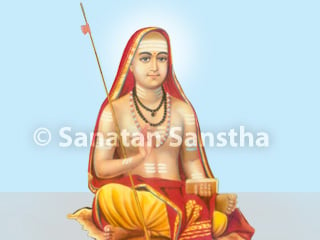
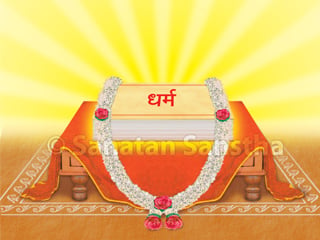 What is the true meaning of word Dharma (Righteousness) ?
What is the true meaning of word Dharma (Righteousness) ?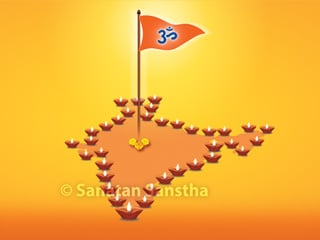 Dharma (Righteousness) and the importance of India (Bharat)
Dharma (Righteousness) and the importance of India (Bharat)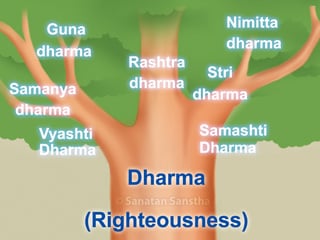 Types of Dharma (Righteousness)
Types of Dharma (Righteousness)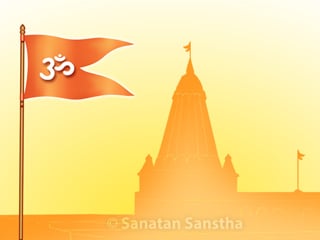 Hindu Dharma
Hindu Dharma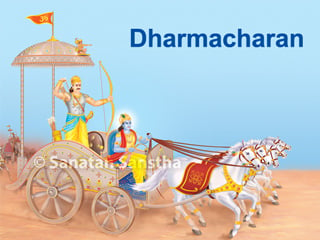 Why is it essential to adhere to Righteousness (Living Dharma) ?
Why is it essential to adhere to Righteousness (Living Dharma) ?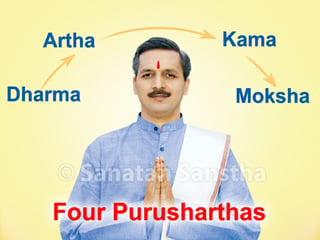 Dharmasiddhant - Principles of Hinduism (Doctrines of Dharma [Righteousness] )
Dharmasiddhant - Principles of Hinduism (Doctrines of Dharma [Righteousness] )